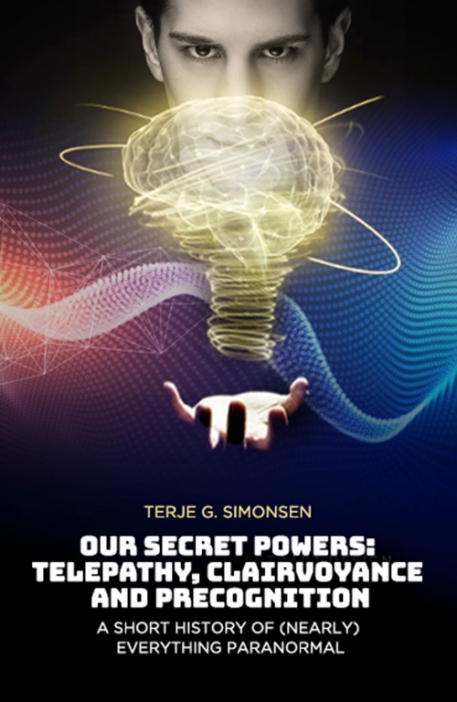
Reviewed by Nemo C. Mörck
Terje Simonsen is a Norwegian historian of ideas, he used to teach at Oslo University, but nowadays he is a freelance writer. While writing Our Secret Powers he received support from the Norwegian Non-fiction Literature Fund and from the Fritt Ord Foundation. Although it is not made clear, except in the acknowledgements, the book is mainly a translation, the original, Våre Skjulte Evner, was published in 2014. Some sections could have benefited from an update. The book is easy to read, but rambling, with many asides, book recommendations, quotes and parentheses. The relevance of everything is not clear. Simonsen's writing style is meant to be amusing, but some readers might find it annoying. The book consists of about 500 pages text, a bibliography, an author index, and a subject index.
In particular, Simonsen appears to enjoy retelling stories about paranormal experiences, but the book is wide-ranging as its title suggests. Simonsen writes about consciousness, anthropologists and their experiences, famous psychics, and touch on experimental parapsychology. He writes about Freud and Jung, but also about Georgi Lozanov, Stanislav Grof and Milan Ryzl. However, the research Ryzl is best known for, namely the studies with Pavel Štěpánek is not mentioned. Simonsen also writes about Swedenborg, Mesmer, Abbé Faria and William James. In addition, he shares some stories from Norway about psychics and paranormal experiences. A chapter is also devoted to scepticism and the Committee for Skeptical Inquiry. The historical sections are necessarily a bit sketchy, but it seems clear that Simonsen must have read far more than the modest bibliography suggest. There are some errors, for example, James was not the first president of the American Society for Psychical Research, but, in general, the coverage seems acceptable.
Simonsen could have stuck to telling stories about psychics, paranormal experiences and researchers, but he also touches on experimental parapsychology. He writes that Robert Thouless (President of the SPR, 1942-1944) introduced and coined the term psi, but in the paper he refers to Thouless (1942), in fact, wrote: ”I suggest the adoption of a term suggested by Dr [Bertold Paul] Wiesner” (p. 22). His wording suggests that J.B. Rhine was the sole author of Extra-Sensory Perception After Sixty Years (Pratt et al., 1940). The first Ganzfeld studies were not conducted by parapsychologists in the late 1960s and needless to say, in contrast to Simonsen's claim, 2500 Ganzfeld studies have certainly not been conducted. The section about the Maimonides dream ESP studies leaves the reader with the impression that this line of research died out after some replication studies had been conducted. All this is unfortunate.
Some sections suggest that Simonsen is not too familiar with the research. In passing, he refer to Stephan Schwartz as a ”psychic archaeologist” (p. 70) and erroneously claim that Schwartz owned the submersible Taurus which was used in an experiment. Since remote viewers needed target coordinates (or something else to focus on) remote viewing was, in general, not used to ”locate military installations in foreign countries” (p. 53). In addition, remote viewers were not typically ”recruited from among soldiers-often personnel who repeatedly had managed to survive under 'impossible' conditions” (p. 69). There are other errors and dubious claims in the sections about remote viewing.
Simonsen also writes about presentiment, but the story he relates about Dean Radin's first presentiment study is not consistent with Radin's own account. According to Simonsen ”... he became fascinated with those soldiers who were capable of surviving seemingly against all odds. Radin thought that perhaps this surprising capacity to anticipate and avoid danger ... was based not only on lessons learned from past experiences but that precognition could also play a part” (p. 385). According to Simonsen he thought about this while working within the Star Gate program, hence I guess Simonsen means when Radin was Visiting Scientist at SRI International in 1985. Simonsen writes that the participants in the first study were soldiers. According to Radin's (2006) own account he got the idea for the presentiment studies in 1993, while working at the University of Edinburgh. His first presentiment study was conducted at the University of Nevada.
In a long, wide-ranging, book some errors are inevitable. There are many popular books about parapsychology, many of them are little better than this one. However, some of the errors uncovered make me wonder about the accuracy of sections concerning individuals and research that I am not too familiar with. I do however believe that the sections that do not concern experimental parapsychology are more readable. The book is chatty and easy to read, some readers will also enjoy Simonsen's humour, the book should however be regarded as more entertaining than scientific.
References
Pratt, J. G., Rhine, J. B., Smith, B. M., Stuart, C. E., & Greenwood, J. A. (1940). Extra-Sensory Perception after Sixty Years. New York: Henry Holt.
Radin, D. (2006). Entangled Minds. New York: Paraview.
Thouless, R. H. (1942). Experiments on paranormal guessing. British Journal of Psychology, 33, 15-27.

